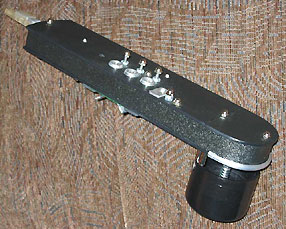Matt's
EVI Gig Rig
June 2003
EVI Gig Rig
June 2003

|
|
|
|
|
|
|
|
|
|

Matt's EVI Gig Rig - June 2003
|
Go to Matt's Gig Rig
Index
Here was my "Gig Rig" circa June 2003...
Since I am always being asked by my wind controller customers what my own "gig rig" consists of, I decided to create a page with some quality photos of my live "EVI Gig Rig" along with some notes as to how I came to choosing the components of my rig. I recently put together a "Gig Rig" for my EVI to play out with my group. Money wasn't so much an issue as the size and sound quality. The top criteria were that the rig needed to be small yet uncompromising in the sound and playability. I want to be able to load into a gig in one easy trip. Using a dolly, said is possible with this system. Fortunately, the components I chose are not necessarily the most expensive though some are hard to find. After a lot of thought about every possible permutation, I arrived at my current rig as described here.
As you may know, I have extensive personal experience with
wind controllers since I program all the wind controller soundbanks
for Patchman Music. My first hand experience programming and
using so many sound modules with a wind controller has helped
me to focus on what is possible with the current crop of synths
with regards to a wind controller. I have learned what works
best (for me at least) with a wind controller and what to look
for and avoid when deciding on wind controller gear. Hopefully,
this page will help you in your quest for your own "Ultimate
Wind Controller Gig Rig".
Since I am originally a trumpet player, the wind controllers I use are the MIDI EVI (as shown at right) and MDT. The MDT is currently in prototype form. Click here for details on the MDT. You can read all about the Nyle Steiner MIDI EVI here. Learning these instruments, or any other wind controller, takes time. It took me several months to get comfortable enough with the fingering to be able to play them in public. It also takes time to get used to the mouthpiece and other controls on the instrument but the effort is well worth it. Playing a wind controller takes very little embouchure so I can sound great even after several weeks away from the instrument. Try that with a trumpet! Also, a wind controller gives a single instrumentalist the ability to emulate many different instruments. In fact, you can even sound like multiple instruments at once with the proper layered synthesizer patches. Because if this, a wind controller can open up vast possibilities for a musician who is looking to work professionally. Such versatility is a very valuable commodity. Plus, it's just a lot of fun to play!
Please note that the actual wind controller you use isn't terribly critical since most wind controllers transmit basically the same MIDI data. I use the MIDI EVI because it is currently the only choice trumpet and brass players have. There are several choices available to sax and reed players such as the Yamaha WX5, WX11, WX7, the Akai EWI3020, and the Softwind Synthophone. Patchman Music also sells lots of used wind controllers and wind controller related synths and gear on the Patchman Music Used Gear Page.
Here is a synopsis of how I am currently using my gig rig which consists of three VL70-m modules...
In the groups I am currently playing with I am the only horn player so I am handling all the horn duties. These groups do mostly country club jobs and upscale weddings and dinner dances. We do all styles of music.
Below is a quick picture of my gig rig circa May 2003 as set up at a recent gig. The picture isn't great but you will get the idea of what my rig looks like.

As far as controllers go, I have been switching between the MDT and MIDI EVI. I just happened to use the MDT for this particular gig. I am now using 3 VL70-ms, a Boss SE-70 for effects, and a TOA D3 mixer in my three space "anvil-type" rack case.
You all know about the VL70-m, and probably about the SE-70. It's great to layer 3 physical modelling voices to create a dynamic, responsive, and "alive" horn section. I'm thrilled with the results I am getting. Amazing stuff. Each of my VL70-m modules is loaded with the Patchman Music TURBO VL chip. Details on that are here- https://www.patchmanmusic.com/turbovl.html
I usually am playing all the VL70-m modules simultaneously either on the same note, or I transpose one or two of them an octave. I generally do not find the use of chordal layers to be helpful in my situation. Then when I play a solo I mute two of the VL70-m's using my TOA mixer and play one of them as the solo instrument. I'm still looking into ways to be able to switch from a three voice section sound to a solo sounds (which is louder) and back to a section sound without missing a beat.
I am using the VL70-m Internal bank to create and store my layers. The Internal bank has 64 locations that allow me to select my favorites form the 256 built in TURBO VL sounds. Of course I can still access any of these 256 sounds by switching a module to one of the Pre banks. By putting all my choices in the Internal bank, I can then send a MIDI Program Change to select amongst them. If I desire a single solo Voice, I simply set the volume of the patch in the other two VLs to 0. So all 3 modules are always playing- you just don't hear them all the time.
Some of my favorite layers to use are the "Chicago horn section sound" which can be: Trumpet, Tenor Sax, and Trombone or maybe Flugelhorn, Alto Sax, and Trombone. Often times the trombone plays up an octave so it is in unison with the trumpet/flugel.
The TOA mixer is the only one I could find anywhere that had the exact features I needed for my particular my wind controller rig. It has a main stereo out with separate volume knobs for Left and Right for that. Then, most conveniently, it has a separate MONO SUM OUTPUT which is used for my powered monitor. There is a separate volume knob for the SUM OUT. Then it has a 1/4" stereo headphone jack on the front also with a separate volume knob for it. It has 4 STEREO inputs (2 inputs on each) each with volume, pan, high and low eq, and effects send. Input number 4 also accepts a phantom powered mic complete with 48v switchable phantom power and XLR jack! I use the Mic input for my vocal mic. It has an AC cord (no wall wart!), and also stereo effects returns and stereo tape returns (again both with knobs), LED clip indicators on each input plus overall clip LED. These are really excellent mixers and they seem to be designed exactly for this type of application. Unfortunately, they have been out of production for a long time. By the way, I try to maintain a stock of these mixers on my used gear page at:
https://www.patchmanmusic.com/UsedGear.html
This rig allows me to really sound like a horn section as well as pretty much any solo instrument. I highly doubt a whole lot of folks could tell it was synthesized at this point if they were just listening and not seeing me. The three VL70-m's really are nice because a patch in each of those modules responds slightly different and this creates a very "living" type of sound that a sample playback synth simply cannot do. I think of each of my VL70-m's as single musicians. Three seems to be a good number for now. Four might be better, but the band Chicago has trumpet, trombone, and sax so I figure that's a good enough sound to go after.
I haven't sold my QSR. It's still great for string section sounds and many other things including sample playback with excellent legato. I may add it back into the rig at some point. But for now I'm trying to keep the rig to where I can actually lift it to load it in the car! It's really heavy as it is now in that anvil case and I am able to get a passable string section sound using layers on the VLs with custom VL70-m patches I have done.
----------
Wired in the back is also a Midi Solutions Router. Below are the details on each component. Please note that the synthesizer you use and the patches loaded in the synth are really 50% of the rig. It is VITAL that you choose a synth that is capable of responding properly and quickly to the MIDI data a wind controller transmits. Some synths simply cannot be made to work well with a wind controller due to limitations in their internal patch programming capabilities and synthesis structures. Fortunately, a large library of professional commercial soundbanks is available from Patchman Music. Click here for a list of synthesizers that is supported by Patchman Music quality wind controller patch soundbanks.
Yamaha VL70-m Physical Modeling Sound Module
There is nothing like playing a VL Physical Modeling synth with quality patches with a wind controller. The VL is just a monophonic module (more precisely, stereo but with one note of polyphony), but when layered with the QSR it adds a great deal of reality to the sound. Of course it sounds great solo as well. The big limitation with the VL70-m is its small Custom bank size- just 6 Voices. But I overcome this by utilizing the QSR's Midifile playback function to quickly load sets of 6 Custom Voices into the VL70-m without the need for an external data filer. Great for live gigs! You could also use the Midifile playback to play sequences within the QSR and jam over them on the VL70-m. (This limitation has since been alleviated with the release of the Patchman Music TURBO VL upgrade chip for the Yamaha VL70-m.) Of course I use the Patchman Music VL70-m soundbanks in my VL70-m. MP3 demos and complete info on the Patchman Music VL70-m wind controller soundbanks is available here.
Boss SE-70 Super Effects Processor
The Boss SE-70 is an amazing device. Aside from great sounding reverbs, delays, etc..., it has several effects that are not commonly found on other effects processors. It has 2 vocoders, a guitar synth, bass synth, (these synths can track any mono acoustic instrument complete with a dynamic enveloped filter and amp envelope!), a tuner, a 60 cycle hum remover, a vocal remover, TRUE stereo reverbs (stereo in and out), great sounding distortions and pitch shifters, a 20(!) tap delay, 16 stage chorus, 40 stage phaser, a sampler, and on and on. It can chain a large amount of effects for massive processing. It can respond to MIDI controllers and up to 3 pedals. It's a pretty cool device. It is capable of doing all sorts of things to your sounds. The guitar and bass synths algorithms can be used with the acoustic trumpet or flugelhorn as pitch-tracking synthesizers! That's right, this thing will track your horn and synthesize it (internally only- it doesn't do pitch to MIDI conversion). It sounds great!
Anvil 3 Space "Forge II" Rack
A super heavy duty 3 space rack case. This one is about as small as you can get for 3 rack spaces yet it is built like a tank.
On-Stage Stands Rack Stand Model OSS RS7000B
This is my solution to getting the rack up high enough for easy access while playing. I believe this stand was designed for holding a small guitar amp. But I turned the two rails 180 degrees and use it as a rack stand. It's a great way to go. Since I can easily get to the rack without having to stoop down, I am eliminating the need to have a foot controller. A foot controller is still an option, but for the sake of size, I am trying to live without one for the time being.
PATCHMAN MUSIC HOME | Wind Controller Soundbanks
| Be sure to check out the amazing Aerophone Academy Podcast co-hosted by Patchman Music's own Matt Traum and Alistair Parnell (iSax Academy) for in depth discussions and interviews on everything related to wind controllers! |


Check out the INCREDIBLE PATCHMAN TURBO VL Upgrade Chip for the Yamaha VL70-m |

This page was last updated Wednesday, August 6, 2025
Copyright ©1996-2025 PATCHMAN MUSIC, LLC, All Rights Reserved
Purchase Terms and Conditions
All trademarks are property of their respective holders

